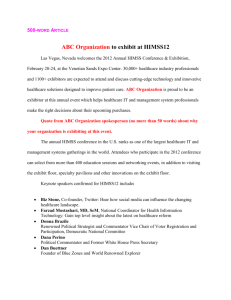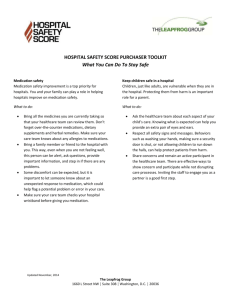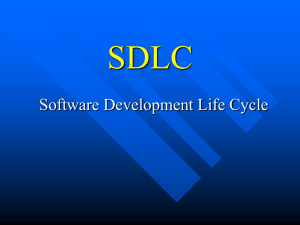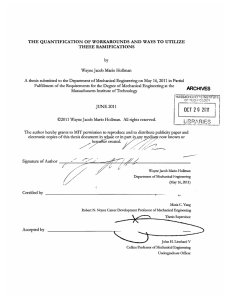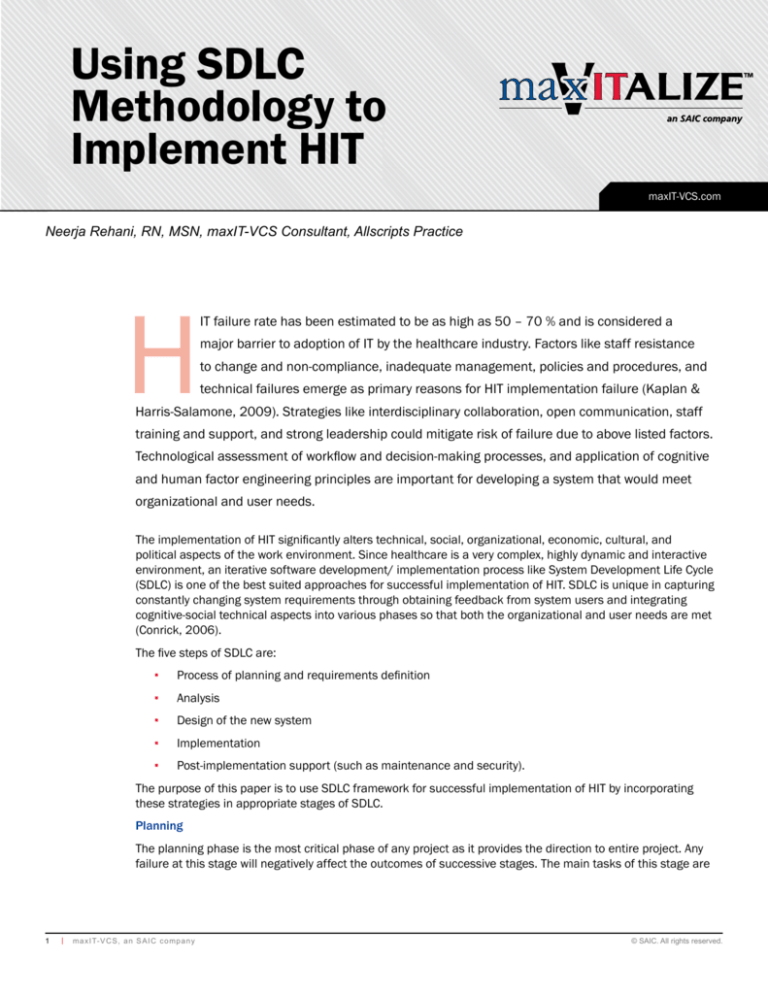
Using SDLC
Methodology to
Implement HIT
maxit-VCS.com
Neerja Rehani, RN, MSN, maxIT-VCS Consultant, Allscripts Practice
H
IT failure rate has been estimated to be as high as 50 – 70 % and is considered a
major barrier to adoption of IT by the healthcare industry. Factors like staff resistance
to change and non-compliance, inadequate management, policies and procedures, and
technical failures emerge as primary reasons for HIT implementation failure (Kaplan &
Harris-Salamone, 2009). Strategies like interdisciplinary collaboration, open communication, staff
training and support, and strong leadership could mitigate risk of failure due to above listed factors.
Technological assessment of workflow and decision-making processes, and application of cognitive
and human factor engineering principles are important for developing a system that would meet
organizational and user needs.
The implementation of HIT significantly alters technical, social, organizational, economic, cultural, and
political aspects of the work environment. Since healthcare is a very complex, highly dynamic and interactive
environment, an iterative software development/ implementation process like System Development Life Cycle
(SDLC) is one of the best suited approaches for successful implementation of HIT. SDLC is unique in capturing
constantly changing system requirements through obtaining feedback from system users and integrating
cognitive-social technical aspects into various phases so that both the organizational and user needs are met
(Conrick, 2006).
The five steps of SDLC are:
▪▪
Process of planning and requirements definition
▪▪
Analysis
▪▪
Design of the new system
▪▪
Implementation
▪▪
Post-implementation support (such as maintenance and security).
The purpose of this paper is to use SDLC framework for successful implementation of HIT by incorporating
these strategies in appropriate stages of SDLC.
Planning
The planning phase is the most critical phase of any project as it provides the direction to entire project. Any
failure at this stage will negatively affect the outcomes of successive stages. The main tasks of this stage are
1
|
m axIT-V C S , a n S A IC c om pany
© SAIC. All rights reserved.
SDLC Methodology
maxit-VCS.com
defining the scope and problems, exploring possible solutions, selecting the solution by conducting feasibility
tests, developing the project schedule, assimilating required resources for the project, and launching the
project.
Identify and define goals.
Identifying objectives and establishing shared deliverables of the project is critical to contain the scope of the
project and is also instrumental in gaining long-term commitment, support, and acceptance from the users.
The patient should be established as the beneficiary of HIT to make sure that the objectives will not be altered
frequently based on the dynamics of stakeholder relationships during project development (Lapointe & Rivard,
2005). To develop safe and acceptable systems, clinicians who understand the clinical workflow and processes
should be actively involved in the selection and customization process.
Open communication and collaboration.
Open communication of the purpose and objective of the project is imperative for clinician engagement and
early buy-in. Setting realistic expectations from the system provides opportunity to clarify objectives, formulate
perception of outcomes and benefits, and give psychological ownership to all participants (Blake, et al. 2010).
Establishing a robust communication plan is necessary for collaboration, synchronization, and transparency
of developmental process. The feedback received from users is critical to the adaptive process of SDLC for
customization and optimization of HIT.
Strong and visible leadership.
The leadership should reinforce the commitment to its vision and guiding principles at all levels to gain
collaboration and acceptance from all stakeholders. It should help to resolve any conflicts and to create a
sense of urgency for the need of new technology. For example, ineffective leadership at a recent client created
a climate of conflict that resulted in complete implementation failure of the information system.
Feasibility determination.
Confirm the feasibility of the project from several different perspectives; technical, economic, and
organizational. To mitigate the risk of going over-budget (besides the obvious costs of acquiring the technology
and cost of human and financial resource required for implementation), training and support should be
considered. Items that should be factored in feasibility and evaluation for budget allocation are: Compatibility
and interoperability of a selected system with existing infrastructure, additional investment in infrastructure,
additional staffing needs, training and support provisions, and resources for customization and redesign of the
system (HIMSS, 2008).
Analysis.
Tasks of the analysis phase are prioritizing the requirements, generating and evaluating the alternatives,
reviewing the organizational policies, and making recommendations for management. The systems developed
or customized based on erroneous requirement specifications do not meet organizational and user needs and
cause delays, data loss, errors, and breakdown of communication processes (Koppel et al. 2008).
Changes in communication.
Communication functions and patterns are embedded into the work processes and artifacts. The
implementation of HIT drastically changes the communication patterns and processes, and reorganizes interdepartmental relationships. Since the process of clinical decision-making relies heavily on communication
processes and information flow amongst members of interdisciplinary teams, to understand the functionality
of the artifacts and identify user needs, analysts should use direct observations with interviews and surveys for
process mapping and analyzing the workflow (Bisantz, 2008).
User needs and cognitive aspects.
Staff resistance usually originates from the fact that the system does not meet their needs or the design is
not compatible with the workflow. Techniques like cognitive task analysis, cognitive engineering, ergonomic
evaluation, and human factor engineering help in identifying concepts, contextual cues, goals, and strategies
2
|
m axIT-V C S , a n S A IC c om pany
© SAIC. All rights reserved.
SDLC Methodology
maxit-VCS.com
employed by users to understand cognitive processing of given tasks. This is important for user interface
development (Weir et al. 2007).
Infrastructure and system requirements.
Analyzing technical requirements of the system is an important component of the analysis stage. It is
imperative to analyze the additional demands made on ancillary departments for hardware, software, staffing
and space needs, as well as policy changes required to accommodate new technology. Pilot testing for
compatibility with existing infrastructure and technology should be done. Alternatives should be evaluated and
matched with the needs of the organization, existing infrastructure, and the technology under consideration.
Other system requirements, such as wireless connectivity and AC outlets for docking mobile units, should be
analyzed to avoid surprises in implementation stage.
Reconfiguration of policies and processes.
The statement by David Liebovitz, “The conversion to electronic medical records shines a bright light
on problematic paper processes,” summarizes the importance of analyzing the workflow processes,
communication, decision-making tools and organizational policies. Technology alone cannot overcome
ineffective processes. Recommendations should be made to institute organizational policies and procedures
that are compatible with new work processes and technology. To minimize interruptions to the process and
workarounds, and maximize the accuracy and efficiency of the system, in-depth analysis should identify the
functionality and constraints of each process in order to assign tasks to computer or humans to exploit their
respective strengths (Pingenot et al. 2009).
Design.
The design phase determines the architecture and operation of the system with regard to processes, hardware,
software, networking, data retrieval, archiving and use, user interface, etc.
Understanding purpose and system interactions.
The system is designed based on the purpose of the system, system requirements, and user needs determined
in two earlier phases. It is important to reinforce that primary purpose of all tasks is to improve patient safety. A
well designed system should assist the users, accommodate workflow, and support the cognitive processes. If
the designer is not cognizant of user needs, the application of the system, system interaction with environment
and barriers to its optimal utilization, the system could introduce unintended consequences that might
jeopardize patient safety (Bisantz, 2008; Koppel et al. 2008).
Establishing communication pathways.
The system should be interoperable, have built-in communication pathways for flow of information, and a
robust user interface to recognize and mitigate potential workarounds. The cognitive processes used by
interdisciplinary team members for effective communication should be captured by design to avoid degradation
of coordination. Users should be able to observe the reasoning of automatic processes performed by the
system, and system design should require human involvement to validate the final action (Bisantz, 2008;
Koppel et al. 2008). The user should be able to take manual charge using override functionality.
Avoiding workarounds.
Users circumvent the safety mechanisms of the system by omitting the steps that are perceived as time
consuming and unnecessary, compromising the safety benefit of the function (Cochran et al., 2007; Koppel et
al., 2008). Comprehensive screens should be designed to quickly scan, search and review the information at a
glance. Users tend to develop workarounds if the system is inconvenient to use, has poor usability, and disrupts
workflow due to poor system design.
Customization.
To eliminate the workarounds, off-the-shelf software should be customized to match the needs of users and
organization. The system should be designed to stabilize the work processes and the environment. Screen flow
and embedded clinical decision support in the system should be based on recommendations of cognitive
3
|
m axIT-V C S , a n S A IC c om pany
© SAIC. All rights reserved.
SDLC Methodology
maxit-VCS.com
task analysis. Customization to provide clinical decision support, alarms, and alerts should be carefully
evaluated as excessive and difficult to override alerts cause the user to either ignore or bypass such
checks or ignore alarms (Cochran et al., 2007). System design should maintain a critical balance between
standardization and flexibility to accommodate practices in different specialties, and changing priorities
especially in critical care settings to gain user compliance.
User interface.
User interface is the most visible component of the system design and most important determinant of user
acceptance. An effective interface readily provides critical task information and ensures direct visibility of
relevant information. Users seek workarounds if the system design fails to acknowledge human factors and
ergonomic principles, such as poor placement and storage of equipment, limited access, poor screen design,
etc. Principles of human computer interaction should be used as guiding tenets to design interface (Zhang
et al., 2004). The user interface should be simple and include sufficient information to complete the task.
The layout should be predictable, consistent, and the navigation should be easy. Minimal screen navigation
to complete tasks, use of standardized terminology, appropriate color scheme and font sizes are some of
the features that should be incorporated in design. The clinical decision support features, like alerts and
reminders, should be easily noticeable, easy to override, and strategically used to avoid alert fatigue (Karsh,
2009). Besides ease of use, usability is a critical factor in achieving user support. Any factors that will diminish
the usability, actual or perceived, will make the implementation process more complex and difficult, increase
the possibility of workarounds, and training will be harder and more costly (HIMSS, 2009).
Work processes.
A new system has to be supported by policies and processes to be effective. It is important to design work
processes that are aligned and integrated with technology for building effective, interoperable communication
networks (Pirnejad, Bal, & Berg 2008). The organizational policies and procedures should be redesigned to
be compatible with the changes brought about by BCMA implementation. System design should comply with
security and confidentiality protocols required by organizational and regulatory bodies like JCAHO and National
Committee for Quality Assurance (NCQA), and the design should be flexible to incorporate new regulations as
they apply.
Implementation.
In this phase, the system is customized, tested, and installed. Staff training, system maintenance, and
evaluation of outcomes are essential components during the implementation process. The system flaws
are evaluated and redesigned. This phase culminates only with retirement of the system. Maintenance and
support is a continuous process. The maximum amount of time, finance, and human resources are invested in
implementation phase.
Implementing IT projects in any setting can be difficult, but healthcare presents even more challenges because
of multiple stakeholders with individual sets of system requirements and several perceived or actual conflicting
roles, interdisciplinary dependence, complicated communication patterns, and multiple regulatory and
ethical constraints (McManus & Wood-Harper, 2007). A strong and visible leadership support is imperative to
address all the complexities of healthcare and to facilitate effective communication and change management
processes while seeking collaboration from all stakeholders.
Ensure two-way communication.
Communication process between the staff and management should be a feedback loop. Expectations from
the system and the users need to be clear and punitive actions for reported errors need to be discouraged.
Various organizations have found that the strategies like establishing focus groups, making safety rounds to
identify workflow and system issues, and soliciting feedback have enabled them to gain staff acceptance, and
redesign the system for better outcomes (Hook et al. 2008). Retrospective analysis of the system and a robust
multidisciplinary quality monitoring system reveals the system flaws (Hidle, 2007). Based on this analysis,
the organizational policies should be redrafted to make them compatible with the changes introduced by
implementation of new technology.
4
|
m axIT-V C S , a n S A IC c om pany
© SAIC. All rights reserved.
SDLC Methodology
maxit-VCS.com
Training and support.
Training and support is a vital strategy to achieve acceptance and compliance by the staff. Adequate training,
continual support, and increased familiarity with the system improves user satisfaction and acceptance of new
IT/IS technology, inculcates adherence to the best practices, and minimizes the negative effects of technical
failures by providing understanding of the technology and its implications (Koppel et al. 2008). Though, one
unintended consequence is over-dependence on technology. To mitigate this risk, it is important to stress to
the users that technology is only a component of a comprehensive patient safety strategy and the technology
should not be considered as replacement for clinical judgment of the nursing staff (Cescon & Etchells, 2008).
Establishing oversight committees and drafting non-compliance policies.
Since the objectives of patient safety, user satisfaction, efficiency, and cost savings could only be realized
if staff is compliant with the new system/technology, policies and regulations have to be enforced to deal
with non-compliance issues. Non-compliance incidents should be investigated to determine the root cause,
maintain compliance and improve the processes to eliminate workarounds. Legal and quality assurance
departments have to be part of this initiative. Strong and committed leadership is necessary to ensure
compliance (Goldstein, 2007).
Evaluation and maintenance.
Project development of any information system in healthcare environments is a dynamic and iterative process
that constantly needs to be adapted to contemporary practices. The changing roles of staff and interpersonal
relationships, and ever evolving technology, environment, and organizational needs have to be constantly
accommodated into system design. Constant evaluation of the system by a designated core multidisciplinary
team should be administered to identify any issues that could undermine its functionality and utilization
(Paoletti et al. 2009). Once a problem is identified, the entire process of planning, analysis, design, and
implementation is repeated.
Constant upgrade and maintenance of databases to ensure viability of the system is also critical for a
successful sustained system. Similarly, the policies and procedures should be updated to support the
technology use.
References.
Bisantz, A. (2008). Cognitive Engineering Applications in healthcare. National Academy of Engineering,
38(4). Retrieved September 30, 2009, from http://www.nae.edu/Publications/TheBridge/Archives/V-384FrontiersofEngineering/CognitiveEngineeringApplicationsinHealthCare.aspx
Blake, R., Massey, A., Balla, H., Cummings, J. & Zotos, A. (2010). Driving health IT implementation success:
Insights from The Christ Hospital. Business Horizons 53, 131—138. doi:10.1016/j.bushor.2009.10.005
Cescon, D., & Etchells, E. (2008). Barcoded Medication Administration: A last line of defense. The Journal of
American Medical Association, 299(18), 2200-2202.
Conrick, M. (2006). Health informatics: transforming healthcare with technology. South Melbourne: Thomson
Social Science Press.
Fowler, B., Sohler, P. & Zarillo, D. (2009). Bar-Code Technology for Medication Administration: Medication
Errors and Nurse Satisfaction. Medsurg Nursing, 18(2), 103-9. Retrieved November 21, 2009 from http://web.
ebscohost.com.proxy-hs.researchport.umd.edu
Goldstein, D., Groen, P., Ponshke, S., & Wine, M. (2007). Medical Informatics 20/20: Quality and Electronic
Health Records through Collaboration, Open Solutions, and Innovation. Sudbury, Mass.: Jones & Bartlett
Publishers.
Healthcare Information and Management Systems Society [HIMSS] (2008). EMR White Paper. Retrieved March
12, 2010 from website of HIMSS http://www.himss.org/content/files/EHR/EMR_FormsWhitePaper.pdf
5
|
m axIT-V C S , a n S A IC c om pany
© SAIC. All rights reserved.
SDLC Methodology
maxit-VCS.com
Hidle, U. (2007). Implementing technology to improve medication safety in healthcare facilities: A literature
review. The Journal of the New York State Nurses Association. Retrieved September 20, 2009, from http://
www.nysna.org/images/pdfs/communications/journal/fl_wntr07.pdf
HIMSS EHR Usability Task Force. (2009). Defining and Testing EMR Usability: Principles and Proposed Methods
of EMR Usability Evaluation and Rating. Retrieved March 12, 2010 from website of HIMSS http://www.himss.
org/content/files/HIMSS_DefiningandTestingEMRUsability.pdf
Hook, J., Pearlstein, J., Samarth, A., & Cusack, C. (2008). Using Barcode Medication Administration to Improve
Quality and Safety Findings from the AHRQ Health IT Portfolio. AHRQ National Resource Center for Health
Information Technology {AHRQ Publication No. 09-0023-EF). Rockville, MD: Agency for Healthcare Research
and Quality
Kaplan, B., & Harris-Salamone, K. (2009). Health IT Success and Failure: Recommendations from Literature
and an AMIA Workshop. Journal of American Medical Information Association, 16, 291-299 doi:10.1197/jamia.
M2997.
Karsh, B. (2009). Clinical Practice Improvement and Redesign: How Change in Workflow Can Be Supported
by Clinical Decision Support. Rerieved March 20, 2010 from website of Agency for Healthcare Research and
Quality. http://healthit.ahrq.gov/images/jun09cdsworkflow/09_0054_ef.html
Koppel, R., Wetterneck, T., Telles, J., & Karsh, T. (2008). Workarounds to Barcode Medication Administration
Systems: Their Occurrences, Causes, and Threats to Patient Safety. Journal of the American Medical
Informatics Association, 15, 408-423. Retrieved September 30, 2009, from http://www.jamia.org/cgi/reprint/
M2616v1.pdf
Lapointe, L., & Rivard. (2005). A multilevel Model of Resistance to Information Technology Implementation.
Management Information Systems Quarterly, 29(3), 461-492. Retrieved March 22, 2010 from www.misq.org/
archivist/bestpaper/Lapointe.pdf
McManus, J., & Wood-Harper, T., (2007). Understanding the sources of information systems project failure.
Management Services (Autumn), 38–43. Retrieved March 3, 2010 from www.ims-productivity.com/user/
custom/journal/.../IMSaut07pg38-43.pdf
Paoletti, R. Suess, T., Lesko, M., Feroli, A., Kennel, J., Mahler, J., & Sauders, T. (2007). Using bar-code
technology and medication observation methodology for safer medication administration. American Journal
Health System Pharmacy, 64, 536-543.
Patterson, E. (2006). Compliance with Intended Use of Bar Code Medication Administration in Acute and
Long-Term Care: An Observational Study. Human Factors: The Journal of the Human Factors and Ergonomics
Society, 48(1), 15-22. doi: 10.1518/001872006776412234
Pingenot, A., Shanteau, J., & Sengstacke, D. (2009). Description of inpatient medication management using
cognitive work analysis. Computers, Informatics, Nursing, 27(6), 379–392.
Pirnejad, H., Bal, R., & Berg, M., (2008). Building an inter-organizational communication network and
challenges for preserving interoperability. International Journal Of Medical Informatic, 77, 818-827.
Weir, C., Nebekar, J., & Hicken, B. (2007). A Cognitive Task Analysis of Information Management Strategies in
a Computerized Provider Order Entry Environment. Journal of the American Medical Informatics Association,
14(1), 65-75.
Zhang, P., Carey, J., Te’eni, D., & Tremaine, M. (2004). Integrating Human-Computer Interaction Development
into the Systems Development Life Cycle: A. Methodology. Proceedings of the Americas Conference on
Information Systems, New York. Retrieved March 25, 2010, from http://www.linknet1.com/sighci/amcis04/
AMCIS_04_Zhang_etal_HCI_in_SDLC.pdf
One Vision. One Passion. Better Healthcare.
500 North Walnut Road,
Kennett Square, PA 19348
Phone: Fax: 610.444.1233
610.444.3327
© SAIC. All rights reserved.
m ax IT- VC S , a n S A I C c o mp a n y



